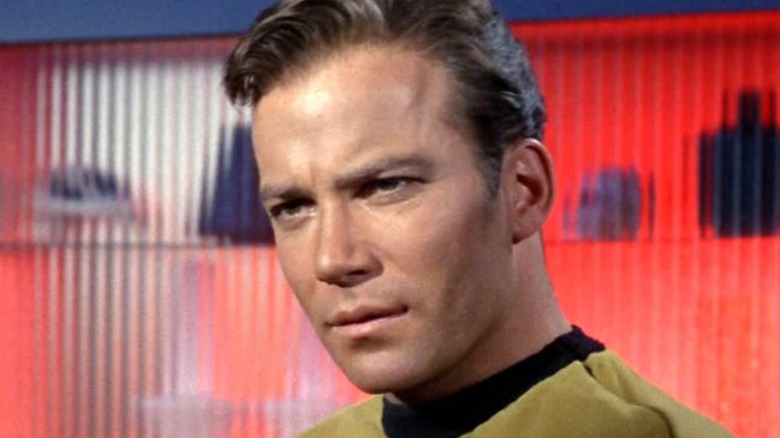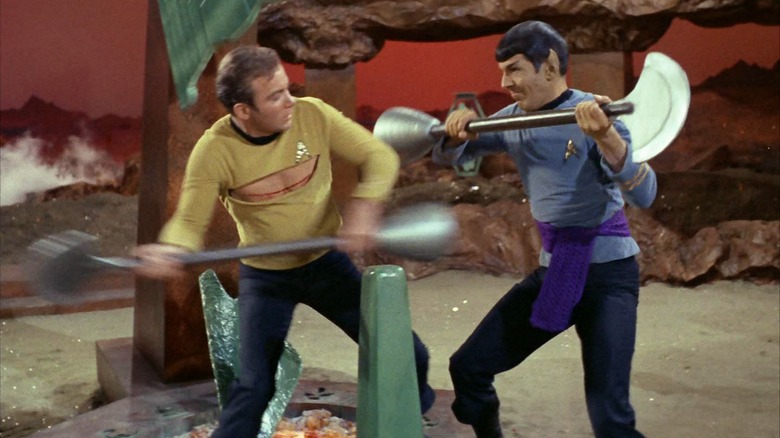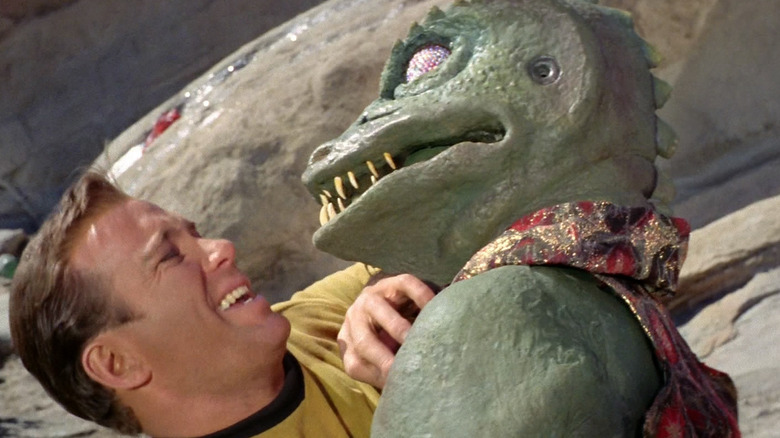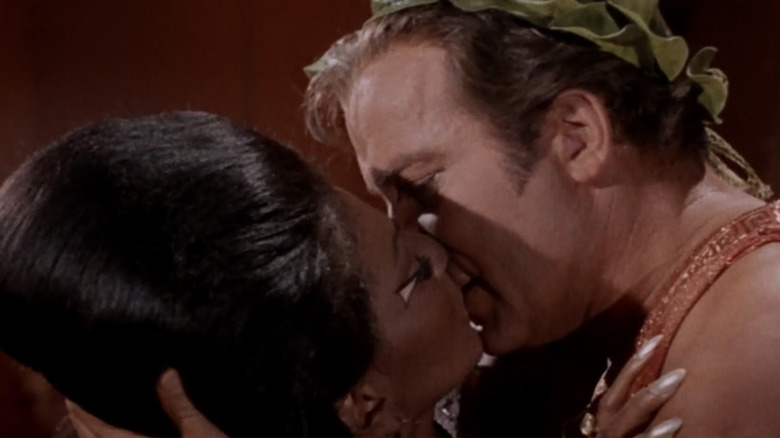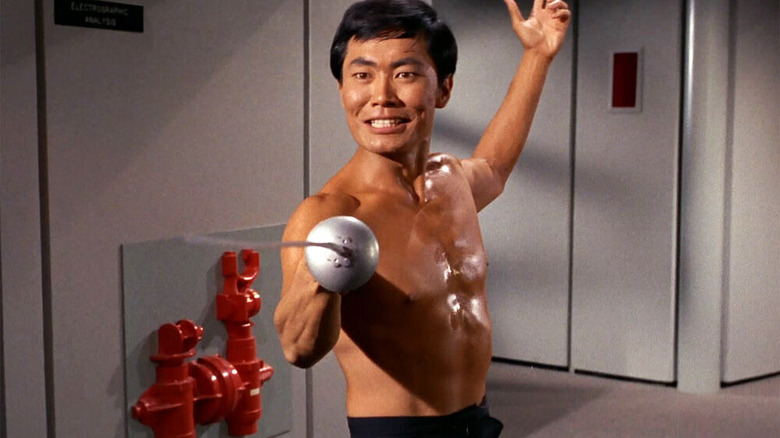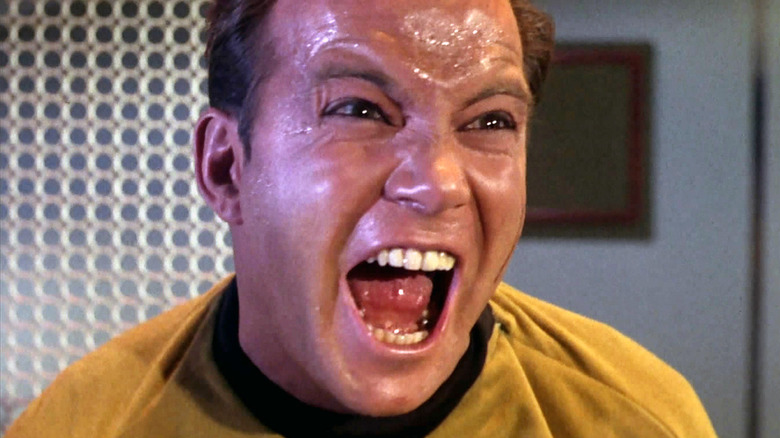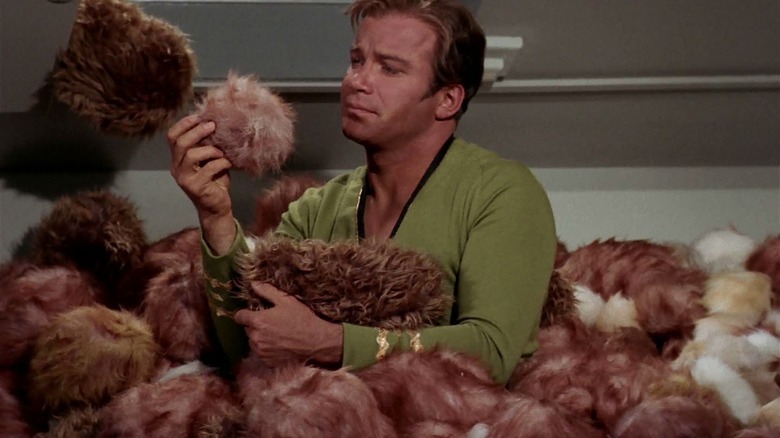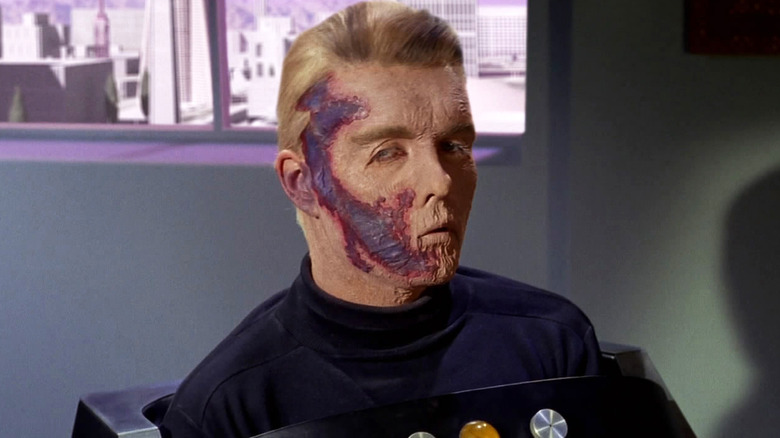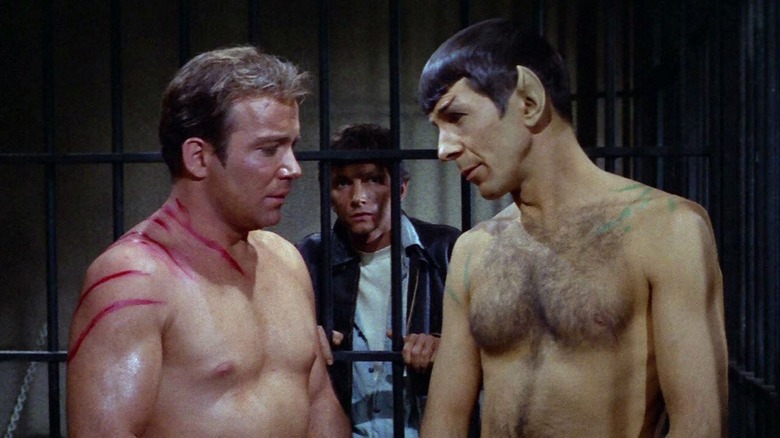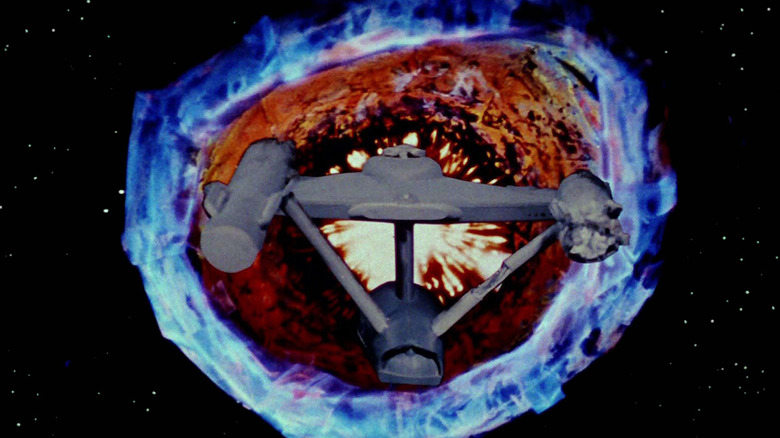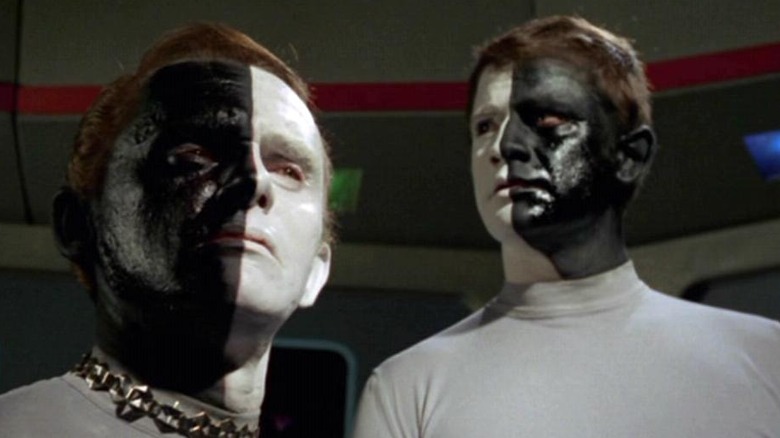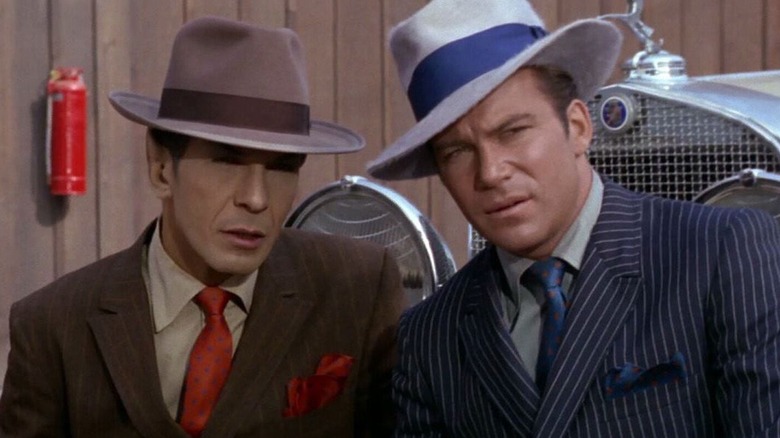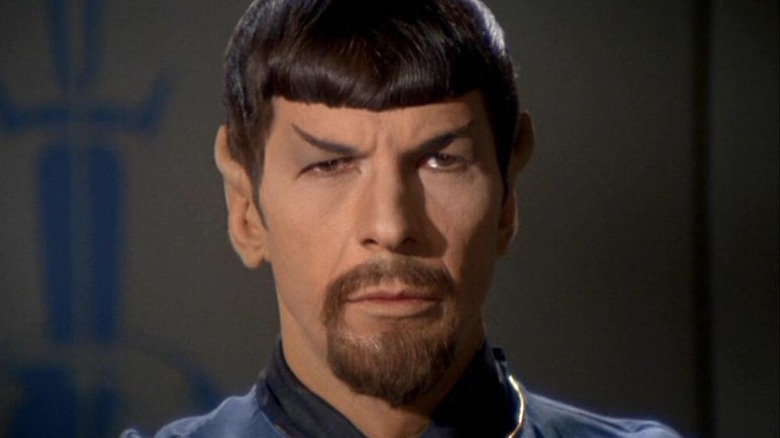The Most Pause-Worthy Moments In The Original Star Trek Series
"Star Trek" just might be the most influential sci-fi franchise ever. And while there have been many "Trek" TV shows, films, comics, and games over the years, it all started with the original series that aired from 1966-1969, following the intrepid crew of the USS Enterprise. The ship was commanded by the heroic Captain James T. Kirk (William Shatner), who was often accompanied by his coldly logical half-Vulcan science officer Mr. Spock (Leonard Nimoy) and the ornery and outspoken Dr. Leonard H. "Bones" McCoy (DeForest Kelly).
As the series intro explains, the Enterprise crew are on a five-year space mission "to explore strange new worlds, to seek out new life and new civilizations, to boldly go where no man has gone before." And the crew certainly did go on a lot of wild adventures, met a myriad of memorable alien creatures, and regularly grappled with highly philosophically and morally complicated issues in the process. This led to some truly iconic moments — moments that, whether you're watching the classic series for the first time or the 500th, you just might want to pause to appreciate.
Kirk and Spock fight
The friendship between William Shatner's Captain Kirk and Leonard Nimoy's Mr. Spock is one of the most enduring and cherished in pop-culture. Despite whatever behind-the-scenes rivalries existed between the actors in real life, their chemistry and camaraderie on screen was impeccable. That's why it was so shocking for audiences to see Kirk and Spock in a fight to the death during the series' Season 2 premiere, "Amok Time."
In that episode, Spock starts to act out in emotionally unstable ways -– a complete 180 from his normally cold and logical demeanor. Turns out, he's suffering from a condition called pon farr, in which every seven years Vulcans are forced to mate... or die.
Against Starfleet orders, Kirk diverts the Enterprise to Spock's Vulcan home world (also called Vulcan) so that his friend Spock can mate and, you know, not die. Unfortunately, due to a lot of convoluted circumstances once on the planet, the pair are forced into a ritualistic fight to the death.
This scene is one of the most classic moments in the series, due to its seemingly high stakes. Furthermore, while it's obvious neither of the show's leads are going to actually die, it does keep you guessing at just how they're going to get out of this situation. There's also the scene's extremely memorable and pulse-pounding score (most notably referenced in the 1996 Jim Carrey-led dark comedy "Cable Guy").
The Gorn
"Star Trek" has showcased many different kinds of alien creatures in its over six-decade history. And while many of them were simply human actors with slight prosthetics on their faces (a la Spock's elf-like Vulcan ears or the forehead ridges introduced to the Klingons in "Star Trek: The Motion Picture"), some were definitely more elaborate. This includes the Gorn — an alien species of reptilian lizardmen, who really pushed the show's make-up effects budget and technical limitations to the limit (or past it, as many fans will attest).
The first Gorn was introduced during the Season 1 episode "Arena," in which Kirk is forced to fight the alien to the death on a barren desert planet. He eventually defeats the nameless Gorn by creating a makeshift weapon from the environment, but decides to show it mercy in the end.
Though many fans have criticized the stuntman's obvious limited movement and lack of vision in the Gorn costume, it's still a memorable moment in "Star Trek" history nonetheless, if only for the ambition of the design itself (though not necessarily its execution). Furthermore, the fight's shooting location, the Vasquez Rocks, has also been used in many other big productions, such as "Blazing Saddles" and "Army of Darkness."
Kirk kisses Uhura
The passionate kiss between Captain Kirk and Lt. Nyota Uhura (Nichelle Nichols) in the Season 3 episode "Plato's Stepchildren" has erroneously and apocryphally been labeled the first interracial kiss on TV. This is not true. However, it does seem to be the first Black-on-white kiss on the lips seen on television, so it's still historically significant nonetheless.
The episode itself is about a race of humanoid aliens with telekinetic powers, who take on the guise of ancient Greeks -– from their clothes, to their architecture, to their culture (which is why Uhura and Kirk are dressed like that during the scene). Most of the episode is devoted to these cruel telekinetic aliens messing with the crew of the Enterprise –- including forcing Kirk and Uhura to kiss against their wills.
Unfortunately, the "mind-controlling" aspect is a bit disheartening, and does take away some of the impact of the moment. But, again, it was still an important step forward, culturally. And despite some predictable backlash, it surprisingly received mostly positive support from fans.
Sulu's shirtless fencing
The shot of a fit, shirtless Commander Hikaru Sulu (played famously by actor-turned-living meme George Takei) crazily brandishing a fencing sword is probably one of the most indelible images of the character in all of "Star Trek." In fact, this single scene became the catalyst for an entire action sequence in the 2009 "Trek" reboot, with John Chu in the role. That's just how memorable the scene is.
The shot itself comes from the early Season 1 episode "The Naked Time." In it, a newly-discovered space virus that's transmitted through skin contact infects most of the crew of the Enterprise. The symptoms of the virus include extremely erratic and impulsive behavior (later described as getting really, really drunk). One of the infected includes the aforementioned Commander Sulu, which is why he's shirtless waving around a sword in the ship like a madman. Like you do.
"The Naked Time" is also notable for being the first episode to introduce the concept of time travel to the "Trek" universe — and wouldn't be the last.
Evil Kirk freak out
William Shatner, while certainly talented, has never been known for subtlety. It's especially fun to see him playing an unabashed villainous character that really lets him ham it up, such as his turn as an Evil Captain Kirk in the Season 1 episode "The Enemy Within."
The episode begins with a transporter malfunction, which causes Kirk to re-materialize as two completely different, distinct personalities –- one that is meek and indecisive (the "Good Kirk"), and one that is a raging, id-driven maniac (the "Evil Kirk").
The shot in question happens during the first stand-off between the two different Kirks, as the Good Kirk tries to reason with the Evil Kirk (who, in turn, doesn't take it well at all). This also wasn't the last time Shatner played opposite himself, as he later played a good twin and an evil twin in the otherwise abysmal low-budget Western "White Comanche."
Kirk surrounded by tribbles
The classic Season 2 episode "The Trouble With Tribbles" is most notable for how overtly comedic and fun it is, as opposed to a lot of the more philosophy-heavy and politically metaphorical episodes the show is most known for.
The episode is about the eponymous tribbles –- cute, little furry creatures -– who reproduce at an alarming rate... to the point that they quickly overrun the entire Enterprise. Kirk discovers this while opening a compartment on the ship and getting completely drowned in a sea of tiny tribbles, a moment which subsequently became one of the most iconic images from all of the original series.
The episode is also very fondly remembered by fans and creators alike. In fact, there are multiple callbacks to it throughout the franchise. First, there was the "Star Trek" animated series (which ran from 1973-1974) with its episode "More Tribbles, More Troubles," a direct sequel to "The Trouble With Tribbles." Then, there was an entire "Deep Space Nine" episode, "Trials and Tribble-ations," in which that show's crew was transported back in time to this episode, with the "DS9" cast digitally composited into the old footage. There's even a reference to tribbles in 2013's "Star Trek Into Darkness," in which Dr. McCoy cruelly experiments on one.
Captain Pike reveal
While most die-hard "Star Trek" fans are undoubtedly already aware of this, there are still some fans who may not know that Captain Kirk was not the original captain of the Enterprise, nor was William Shatner even originally cast on the show at all! Instead, the initial "Star Trek" pilot that creator Gene Roddenberry produced for NBC starred actor Jeffrey Hunter in the role of Captain Christopher Pike. In fact, the only actor and character to transition from the pilot to the series proper was Leonard Nimoy's Spock.
Although the first pilot wasn't picked up, footage from it was later re-used and repurposed for the two-part episode (the only in the entire original series' run) "The Menagerie." This was due to the show's elaborate production getting delayed and going over-budget: re-using the pilot episode footage cut production time in half and allowed the series to catch up. However, the role of the now-deformed and wheelchair-bound Pike was played by actor Sam Kenny.
The introduction of the injured Pike in the futuristic wheelchair (where he is only able to answer "yes" or "no" questions, through a light on the machine) is an iconic and pause-worthy scene, mainly for being one of the most disturbing and tragic images in the entire show. The visceral image of the deformed Pike has also been referenced and parodied many times, including most famously in the "South Park" episode "Pre-School."
Kirk and Spock shirtless
Fan fiction is not a new thing: it has existed as far back as the 1500s, if you want to count "Dante's Inferno" as Biblical fan-fiction. But, in the more modern sense of the term, "Star Trek" was probably the first to popularize it. This includes coining the term "slash" fiction. For the uninitiated, "slash" fiction is the name for a subset of fan-fiction that pairs two otherwise non-romantic characters together ... well ... romantically. This is especially true of fictionalized homosexual relationships, such as Kirk and Spock, with the first Kirk/Spock slash-fic being written as early as 1968. The pairing even has its own name, "Spirk," which William Shatner apparently knows about and approves of.
It's pretty obvious, then, why this shot would be an extremely pause-worthy moment in that particular context. If you are already a fan of "Star Trek" (and especially of "Spirk") slash-fiction, then this scene might be the closest the actual show came to anything resembling those stories.
Unfortunately, the context of the episode is much less tantalizing, of course. In it, Spock and Kirk are captured and tortured by fascist aliens embodying Nazi Germany. But that's what the pause button is for!
The Doomsday Machine
"Star Trek," being the imaginative science fiction program that it was, obviously was no stranger to special effects. This included elaborate model work, complex optical compositing, and even some animation to depict the various alien space ships, planets, and phaser battles that would appear throughout the show. In fact, "Star Trek" stood out in the television landscape of the time for being so imaginative and ambitious. This is especially true given the era in which it was produced, the (relatively) limited budget the network gave it, and the fact it was a weekly television series with quick turnarounds.
All these techniques eventually came out in full-force for the second season episode "The Doomsday Machine." The episode is about a planet-destroying alien weapon (predating the other "Star" franchise's Death Star by almost a decade) that the Enterprise must find a way to stop, or else it could mean the end of the galaxy.
Exciting stuff, to be sure, but the real stand-out is the Doomsday Machine design itself. It has a unique shape, with a shiny crystalline exterior, and a glowing plasma weapon at its center. Even more impressively, it was reportedly created by simply using a wind sock dipped in cement, due to a lack of budget. Nonetheless, the unusual design is ultimately what makes the Doomsday Machine so memorable and pause-worthy anyway.
Aliens in black and white faces
The Season 3 "Star Trek" episode "Let That Be Your Battlefield" is one of the most famous original series entries. The story involves two aliens from the planet Cheron, played by actors Lou Antonio and Frank Gorshin (who portrayed the Riddler on the 1966 "Batman" series), who are at war with each other because one of them has skin that's white on the left side and black on the right, while the other has skin that's black on the left side and white on the right. It is one of the most striking alien designs on the show, and also one of the most elegantly simple.
The fact that the aliens' appearances are so similar, yet that slight difference creates such animosity, is no accident, as it directly commented on the simmering aftermath of the civil rights movement of the mid-to-late '60s. It also perfectly drives the point home of needing to fix racial injustice, and the ridiculousness of racism itself.
Now, unfortunately, there is some dated "bothsidesism" on display in the episode (honestly, it seems Lou Antonio's Lokai and his people got a raw deal, and he was mostly justified in his anger), but it still does what "Trek" does best: using science fiction to comment on present-day social issues in a way that's both entertaining and enlightening. Furthermore, the memorable make-up design, and the allegorical implications of it, definitely make this a pause-worthy moment.
The Enterprise crew as gangsters
"Star Trek" is known for often being very heady, philosophical, and socially conscious, but there are some episodes (like the aforementioned "The Trouble With Tribbles") that are just fun and goofy.
This includes Season 2's "A Piece of the Action," in which the Enterprise crew beam down to a planet where aliens take on the aesthetics and mannerisms of Prohibition-era gangsters — pinstripe suits, fedoras, tommy-guns, the works. This is because another Federation vessel had crash-landed there a century prior and the aliens took a book about 1920s gangsters from the crashed ship as a religious text, basing their entire society around it.
This was, of course, a cost-saving measure on part of the production, since instead of making new futuristic or alien clothes for the episode, they could instead just pilfer gangster apparel from the studio's storage. Nonetheless, this is a classic episode, if for nothing else than seeing the juxtaposition of Kirk and Spock shedding their staid Starfleet uniforms for slick, tailored pinstripe suits and fedoras. They fill them out nicely as well (thus why it's so pause-worthy).
That image is so memorable, in fact, that there were substantial rumors that Quentin Tarantino's ill-fated R-rated "Trek" film was going to be based on this episode.
Evil Spock
The Season 2 "Star Trek" episode "Mirror, Mirror" is one of the show's all-time classics. The story concerns Captain Kirk, Dr. McCoy, Scotty, and Uhura being transported during an ion storm, which causes them to switch places with evil versions of themselves in a parallel dimension. In this universe, there is no longer a United Federation of Planets but instead a Terran Empire, in which this universe's Captain Kirk achieved his position by killing Captain Pike and stealing his command.
The rest of the Mirror Universe crew are also evil versions of themselves — with Chekov and Sulu both attempting to kill the four officers from our universe at one point or another throughout the episode.
As for Mirror Spock, he sports a dark Van Dyke goatee, which is such a striking image that it's become shorthand for "evil doppelganger" ever since. While it's true that the "evil doppelganger" trope had been used throughout literature before then, the inclusion of the beard as a shorthand was first introduced and popularized by "Star Trek" (seen later in things like The Darkest Timeline version of the characters in "Community"), which is why this is such a pause-worthy moment. It is also very ironic, given that Mirror Spock is by far the least evil of the Mirror crew, even saving the "good" characters at the end of the episode.
